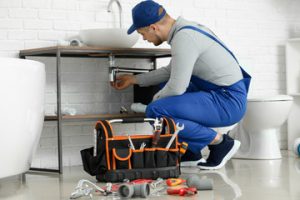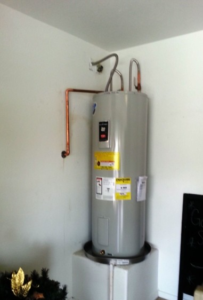Like many skilled trades, becoming a plumber requires extensive training. Many plumbers learn their craft through apprenticeship programs, which can take up to four years.

Plumbing is the system of pipes and fixtures that bring fresh water into buildings and remove wastewater. It is essential for ensuring healthy, sanitary living conditions. Contact Warrior Plumbing, LLC for professional help.
Plumbing is an essential component of architecture, ensuring the smooth flow of water and effective waste disposal. While it may not be the first thing that comes to mind when designing buildings, a well-planned plumbing system can have a significant impact on the functionality and aesthetics of a structure. This is why plumbing design is a crucial element of building construction and renovation projects. It involves the planning and installation of piping systems for water supply, drainage, and ventilation. It also takes into account factors such as code compliance, sustainability, and user comfort.
While traditional plumbing systems are often plagued by issues such as leaks and energy inefficiency, innovative approaches can help address these challenges and pave the way for a more sustainable future. By embracing emerging technologies, prioritizing sustainability, and focusing on user-centric design, architects can revolutionize the way plumbing systems are incorporated into architectural projects.
A good plumbing design requires a thorough understanding of hydraulic principles, building codes, and sustainable practices. It also includes a detailed understanding of pipe sizing and layout. In addition, it must comply with the local water and wastewater management regulations. A plumber with a strong background in these areas can develop a comprehensive and reliable plumbing layout. A high-quality plumbing design can significantly reduce the chances of leaks and other problems down the road.
There are several different types of plumbing systems, each with its own unique set of requirements. For example, potable water systems are responsible for supplying safe drinking water and include pipelines and plumbing fixtures that lead to sinks, toilets, and appliances. Drainage-waste-vent (DWV) systems manage wastewater and vent gases, while specialized systems such as stormwater drainage and fire protection plumbing are also important.
One of the most challenging aspects of plumbing design is ensuring that water pressure is consistent throughout a building, regardless of location or elevation. This can be accomplished by using a sophisticated system of pumps and pressure regulators. For example, the Burj Khalifa, the world’s tallest building, required a unique plumbing solution to deliver water safely to its residents.
Plumbing Regulations
Plumbing regulations are a set of rules and standards that guide the design, installation, and maintenance of plumbing systems. They ensure safety, prevent water wastage and promote system efficiency. Different regions, states, and municipalities have their own set of plumbing codes influenced by national standards but tailored to local needs and conditions.
Whether you’re a homeowner looking to upgrade your plumbing or an experienced contractor, keeping up with the latest codes is essential for success. There are a number of ways to stay on top of changes in the industry, including consulting with experts and attending continuing education classes. Moreover, by maintaining strong connections with other plumbing professionals in your area, you can gain access to resources, publications, and updates specific to your location.
The need for compliance with plumbing regulations has become more important than ever as a result of the increased prevalence of environmental, health, and safety hazards in residential and commercial buildings. For example, faulty venting can lead to drainage problems and foul odors, while non-compliant backflow prevention devices can cause costly water damage.
Consequently, ensuring that your plumbing work is in compliance with regional codes will not only help prevent these issues but also protect you from potential legal and financial consequences. In addition, hiring a plumber who adheres to existing guidelines will improve the longevity of your plumbing system and reduce costs in the long run.
Industrial facilities, like manufacturing plants or warehouses, rely heavily on plumbing systems for various processes and operations. This makes it imperative for them to comply with industrial plumbing regulations. Failure to do so can result in serious fines and penalties. In addition, non-compliant plumbing systems can pose a significant risk to employees and visitors and contribute to environmental harm.
Fortunately, ensuring that your industrial plumbing systems are in compliance with the current codes and regulations will not only help to protect your building’s integrity but will also enhance its functionality and efficiency. The best way to do so is by working with a qualified professional who can offer you expert consultation and support in all areas of your project.
Plumbing Inspections
A well-functioning plumbing system is essential for the smooth running of any home or business. Regular inspections help to minimise the occurrence of leaks, clogs and other problems that can lead to costly repairs. In addition, plumbing inspections can also help to identify potential health issues like contaminated water or even sewage backups.
During a plumbing inspection, inspectors examine the entire system including visible pipes as well as those that are hidden from view. They test for proper water pressure and flow to ensure that fixtures operate properly. They also check for any signs of corrosion or rust in the pipes. Additionally, they inspect drains and sewer lines to ensure that they are free of blockages or clogs. They may use tools such as drain cameras to visually inspect the interior of pipes without removing them.
Leaks are a common problem found during plumbing inspections. They can be caused by a number of factors including faulty seals, loose connections, or corrosion. If left untreated, leaks can cause extensive damage to property and result in high water bills. Inspectors look for any signs of leaks in the pipes and fixtures and recommend appropriate repairs.
Another important part of a plumbing inspection is checking for sanitary fittings that are in good condition and are not leaking or corroding. This includes toilets, faucets, and showers. Inspectors also evaluate water-using appliances such as washing machines and dishwashers for proper operation. Inspectors may also test the water for contaminants such as lead or bacteria and check for any signs of backflow.
A plumbing inspection is an essential step in any home or business purchase. It allows prospective buyers to be aware of any plumbing issues that may need to be addressed and gives them the opportunity to renegotiate the price or request repairs before finalising the sale.
Having a plumbing inspection done regularly can save you money in the long run by identifying any minor issues before they become major problems. It can also help you avoid costly emergency repairs and keep your plumbing system in good working condition for a longer period of time.
Plumbing Codes
In most areas, there are laws in place governing the installation, repair and inspection of plumbing systems. These codes help to protect the health, welfare and safety of people by ensuring that the construction of buildings and their plumbing are up to standards. While the specifics of these codes may vary from region to region, they generally follow a set of guidelines established by international organizations like the ICC and IAPMO. Local and municipal governments may also have their own code provisions to ensure the public’s health, safety and wellbeing.
These codes provide the minimum requirements that builders and plumbers must follow to install plumbing correctly. The codes include specifications such as the correct pipe sizes, fittings and materials to be used. They also cover the proper way to route pipes, including the location of drains and vents. Other important aspects of the plumbing code include specifying the correct system design and sizing, the use of shut-off valves to stop water flow and the provision of cleanouts to make it easier to inspect and maintain drainage systems.
The plumbing in any public or private building makes up part of the community’s water and sewage system. So, having a code that breaks down the best, most up-to-date practices for installation and service is vital. Without such a standard, irresponsible citizens and construction crews could damage this massive infrastructure, creating major problems for the entire community.
A plumbing code can also establish standards for the environment, promoting conservation and efficiency. It can also set minimum standards for sewage disposal, making sure that waste is not polluting groundwater or surface waterways. Finally, a plumbing code can lay out the required handling and installation provisions for certain hazardous substances, such as sewage and chemicals.
The plumbing industry contributes to the development of these codes by attending code development meetings and providing feedback on proposed changes. CISPI represents domestic cast iron soil pipe producers at these meetings, and the Institute works as a partner in the plumbing industry to help develop code provisions that are fair and reasonable for all.
